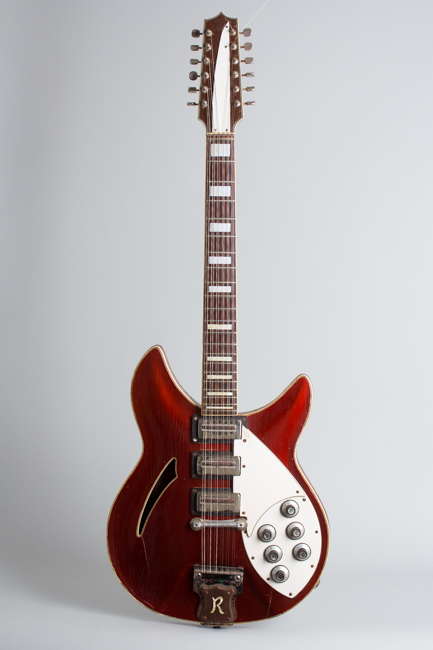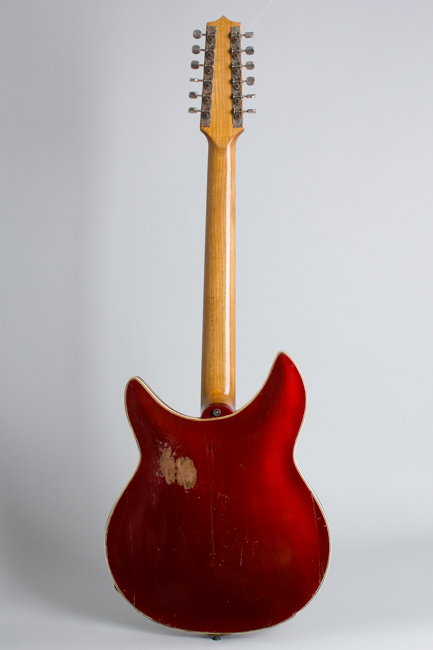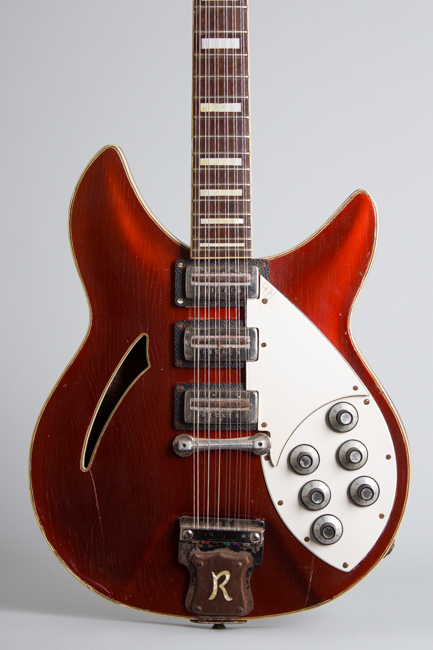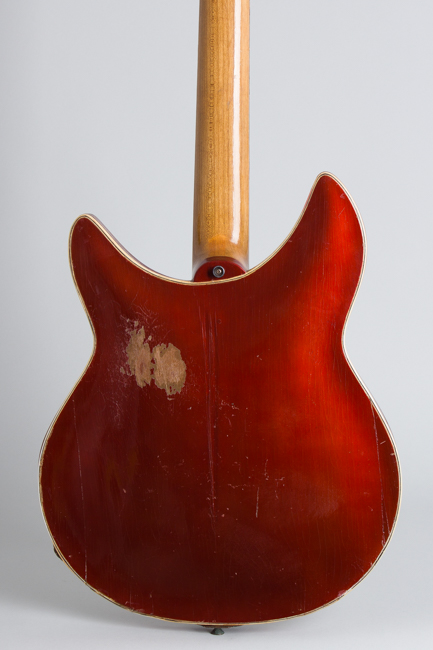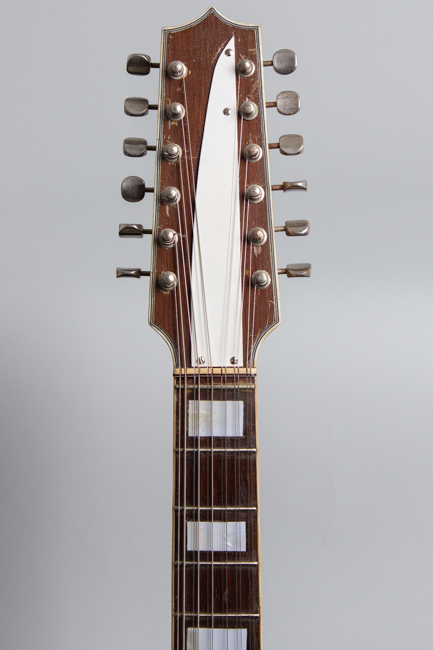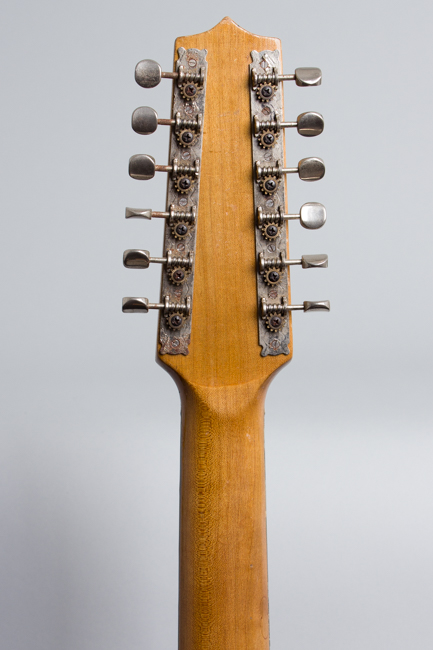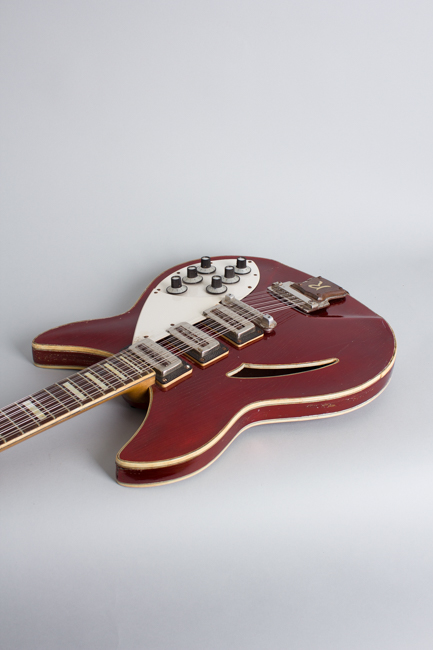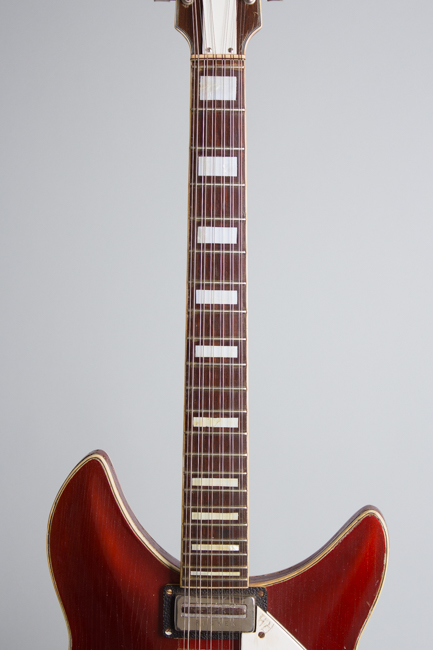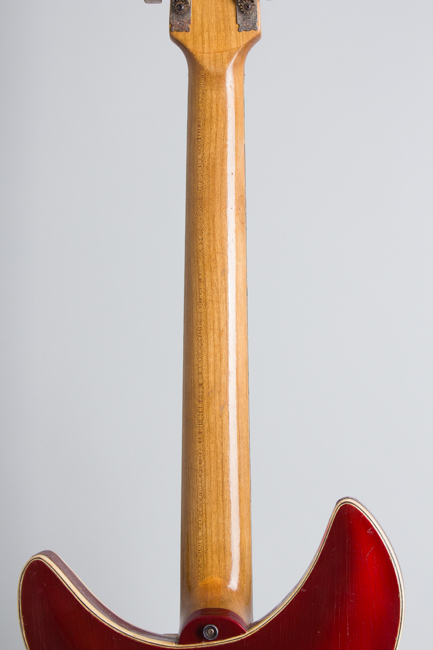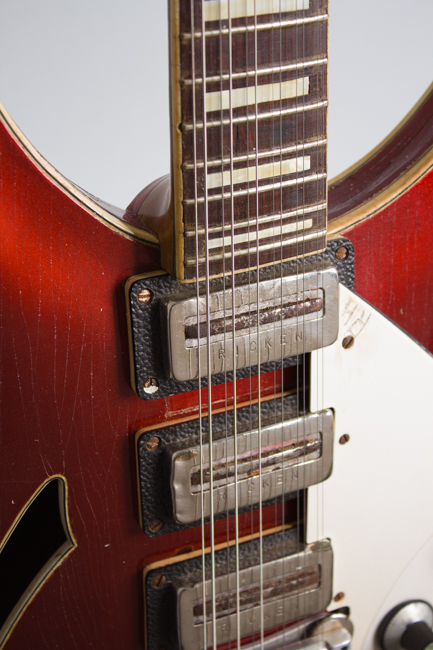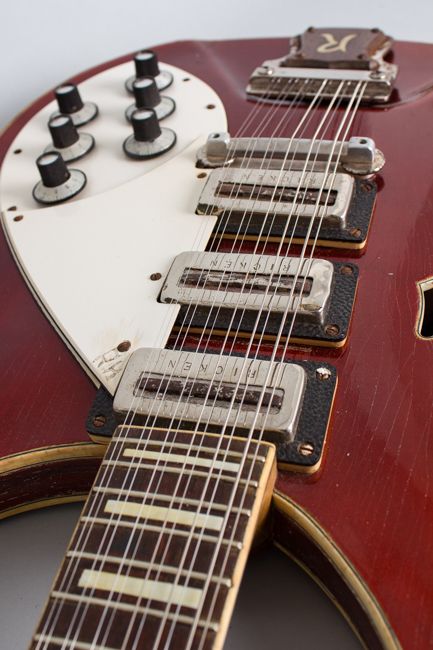Unbranded Ricken Serviceman 12 String Semi-Hollow Body Electric Guitar (1960s)
This item has been sold.
Item # 12066
Prices subject to change without notice.
Unbranded Ricken Serviceman Model 12 String Semi-Hollow Body Electric Guitar (1960s), probably The Phillipines, Candy Apple Red lacquer finish, Nato wood body and neck, rosewood fingerboard, black gig bag case.
When is a Rickenbacker not a Rickenbacker? When it's a "Ricken", a mysterious product of the far east beat boom. We have seen many so-called "Serviceman" guitars, electrics made in the 1960s and '70s for sale mostly to American GIs stationed in the area, including of course Vietnam. Most were built in the Philippines in small workshops so they vary widely in detail and quality and the great majority were Fender copies, most commonly the Jaguar and Stratocaster. THIS instrument, however, is far more unusual in every way.
Obviously the inspiration was a double-bound Rickenbacker 370-12OS, but this is both a cool emulation AND radically different at the same time. The body is closely copied from the Rickenbacker template but is VERY slim at the rim; the top and back are hand carved with some fairly elegant arching. The rims are just thin wood veneer and have suffered numerous cracks and splits over the decades. The finish is a nicely done metallic red, and all body edges are multi-bound including the slash soundhole.
The neck is NOTHING like a Rickenbacker; it is fairly shallow but very wide with a classical-like flat profile. The heel is stacked and the headstock scarf-jointed on. The bound rosewood fingerboard has block plastic inlay and a zero fret. The multi-bound headstock is a fairly elegant pointed shape, obviously the over/under Rickenbacker template was abandoned here, though it does have a long Rick-like nameplate that is blank. There is a metal bar reinforcement in the neck but no adjustable rod. The nut is MUCH wider than a Rickenbacker, which some players might count as an improvement!
The 3 pickups are crude but effective, wound around a central bar magnet. The wiring is the essence of practical, just a tone and volume for each which do not interact allowing for maximum blending versatility. They appear to be wired in series, like a Danelectro. We kind of wish real Rickenbackers were wired this way! They have "Ricken" stamped on the covers, and the heavy tailpiece has an inlaid rosewood block with an "R" emblem. The bridge is a simple metal bar piece, adjustable for height.
In some ways this instrument is fairly crude, in others surprisingly sophisticated. We don't know if it was made for sale to US soldiers or for a more local performer who needed to cover those Beatles and Byrds hits! A genuine Rickenbacker would have been prohibitively expensive in most areas of Asia in the 1960s; they were costly enough here! This is both a historical oddity and a playable instrument; it is functional enough to gig although obviously not to the level of its California inspiration. It really illustrates the cross-currents of American and Asian interactions in the 20th century both musically and historically, and is absolutely the most amazing and beautiful "serviceman' instrument we have ever seen.
Overall length is 41 in. (104.1 cm.), 15 in. (38.1 cm.) wide at lower bout, and 1 3/8 in. (3.5 cm.) in depth, measured at side of rim. Scale length is 24 3/4 in. (629 mm.). Width of nut is 1 3/4 in. (44 mm.).
Although not built to 1960s "professional' standards this is a surprisingly good playing and sounding instrument, although it has taken some tweaking to get it there! The neck is straight, the frets are decent and the pickups actually sound great. The instrument appears all original except for one changed pot. The nicely done finish has checking overall with numerous dings, dents and scrapes and some heavier wear spots to the back and sides.
The sides are very thin wood and have cracked and split in numerous places over the decades; there are some old cracks in the top and back as well. All are solidly glued up but some areas of the side repairs are pretty sloppy, including some patched in binding on the top edge. The neck is quite solid with no such damage, the frets have been polished out and play well. Someone (the original owner?) etched the initials "RH" on the front tip of the upper pickguard.
There is some noticeable corrosion to some metal hardware; this guitar likely spent part of its life in a jungle! There is a rusty metal ring reinforcing the jack. The neck angle is good the bridge has plenty of adjustment room left with a reasonable action. While we offer this guitar primarily as a historical curio it is a playable instrument, and actually sounds quite good, somewhat lusher then the standard Rickenbacker twang with some interesting pickup shadings when the three are blended. Whatever artisans created this piece decades ago took their inspiration from Rickenbacker but created an instrument that has its own character, and probably a great story behind it! Overall Very Good + Condition.
When is a Rickenbacker not a Rickenbacker? When it's a "Ricken", a mysterious product of the far east beat boom. We have seen many so-called "Serviceman" guitars, electrics made in the 1960s and '70s for sale mostly to American GIs stationed in the area, including of course Vietnam. Most were built in the Philippines in small workshops so they vary widely in detail and quality and the great majority were Fender copies, most commonly the Jaguar and Stratocaster. THIS instrument, however, is far more unusual in every way.
Obviously the inspiration was a double-bound Rickenbacker 370-12OS, but this is both a cool emulation AND radically different at the same time. The body is closely copied from the Rickenbacker template but is VERY slim at the rim; the top and back are hand carved with some fairly elegant arching. The rims are just thin wood veneer and have suffered numerous cracks and splits over the decades. The finish is a nicely done metallic red, and all body edges are multi-bound including the slash soundhole.
The neck is NOTHING like a Rickenbacker; it is fairly shallow but very wide with a classical-like flat profile. The heel is stacked and the headstock scarf-jointed on. The bound rosewood fingerboard has block plastic inlay and a zero fret. The multi-bound headstock is a fairly elegant pointed shape, obviously the over/under Rickenbacker template was abandoned here, though it does have a long Rick-like nameplate that is blank. There is a metal bar reinforcement in the neck but no adjustable rod. The nut is MUCH wider than a Rickenbacker, which some players might count as an improvement!
The 3 pickups are crude but effective, wound around a central bar magnet. The wiring is the essence of practical, just a tone and volume for each which do not interact allowing for maximum blending versatility. They appear to be wired in series, like a Danelectro. We kind of wish real Rickenbackers were wired this way! They have "Ricken" stamped on the covers, and the heavy tailpiece has an inlaid rosewood block with an "R" emblem. The bridge is a simple metal bar piece, adjustable for height.
In some ways this instrument is fairly crude, in others surprisingly sophisticated. We don't know if it was made for sale to US soldiers or for a more local performer who needed to cover those Beatles and Byrds hits! A genuine Rickenbacker would have been prohibitively expensive in most areas of Asia in the 1960s; they were costly enough here! This is both a historical oddity and a playable instrument; it is functional enough to gig although obviously not to the level of its California inspiration. It really illustrates the cross-currents of American and Asian interactions in the 20th century both musically and historically, and is absolutely the most amazing and beautiful "serviceman' instrument we have ever seen.
Overall length is 41 in. (104.1 cm.), 15 in. (38.1 cm.) wide at lower bout, and 1 3/8 in. (3.5 cm.) in depth, measured at side of rim. Scale length is 24 3/4 in. (629 mm.). Width of nut is 1 3/4 in. (44 mm.).
Although not built to 1960s "professional' standards this is a surprisingly good playing and sounding instrument, although it has taken some tweaking to get it there! The neck is straight, the frets are decent and the pickups actually sound great. The instrument appears all original except for one changed pot. The nicely done finish has checking overall with numerous dings, dents and scrapes and some heavier wear spots to the back and sides.
The sides are very thin wood and have cracked and split in numerous places over the decades; there are some old cracks in the top and back as well. All are solidly glued up but some areas of the side repairs are pretty sloppy, including some patched in binding on the top edge. The neck is quite solid with no such damage, the frets have been polished out and play well. Someone (the original owner?) etched the initials "RH" on the front tip of the upper pickguard.
There is some noticeable corrosion to some metal hardware; this guitar likely spent part of its life in a jungle! There is a rusty metal ring reinforcing the jack. The neck angle is good the bridge has plenty of adjustment room left with a reasonable action. While we offer this guitar primarily as a historical curio it is a playable instrument, and actually sounds quite good, somewhat lusher then the standard Rickenbacker twang with some interesting pickup shadings when the three are blended. Whatever artisans created this piece decades ago took their inspiration from Rickenbacker but created an instrument that has its own character, and probably a great story behind it! Overall Very Good + Condition.
